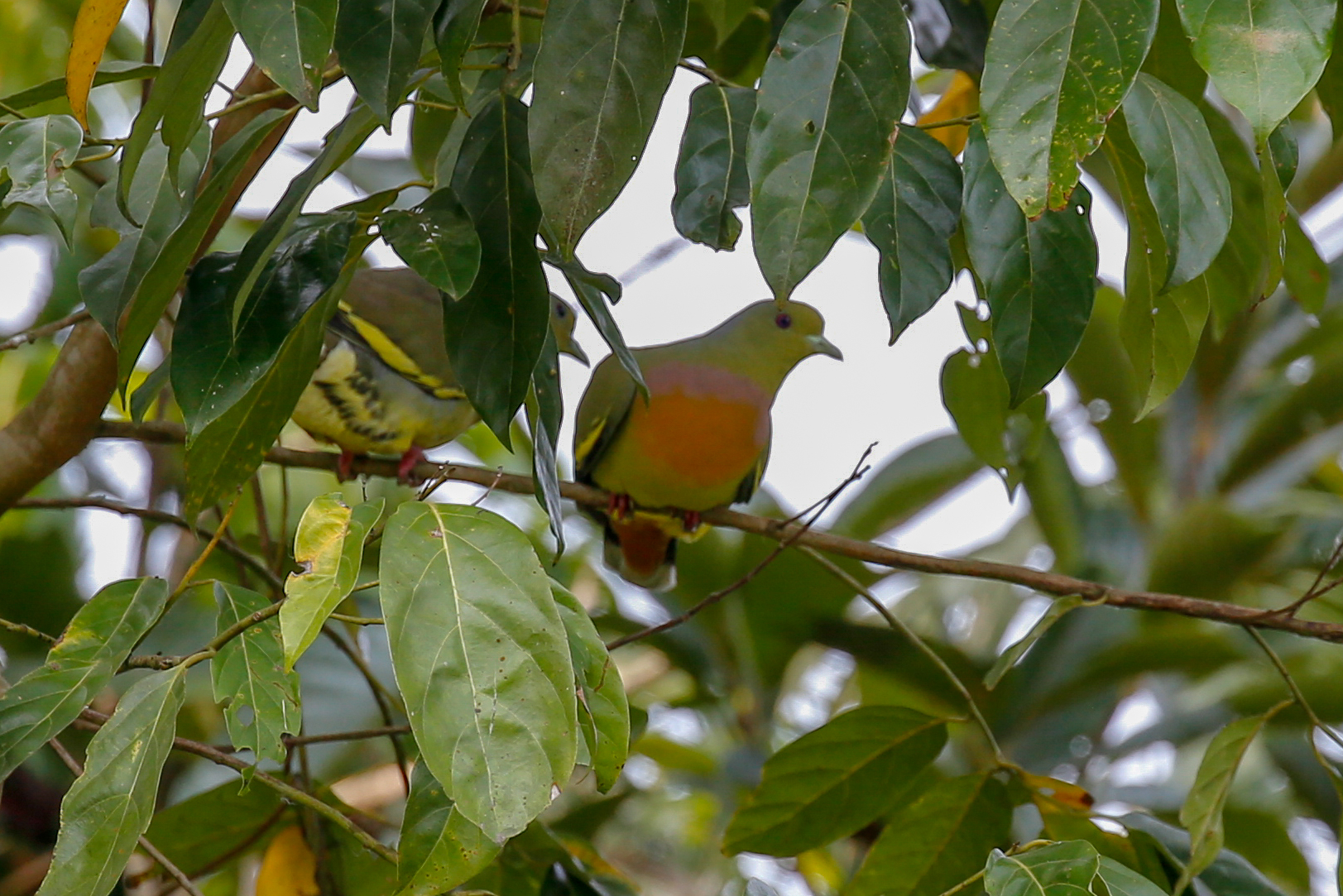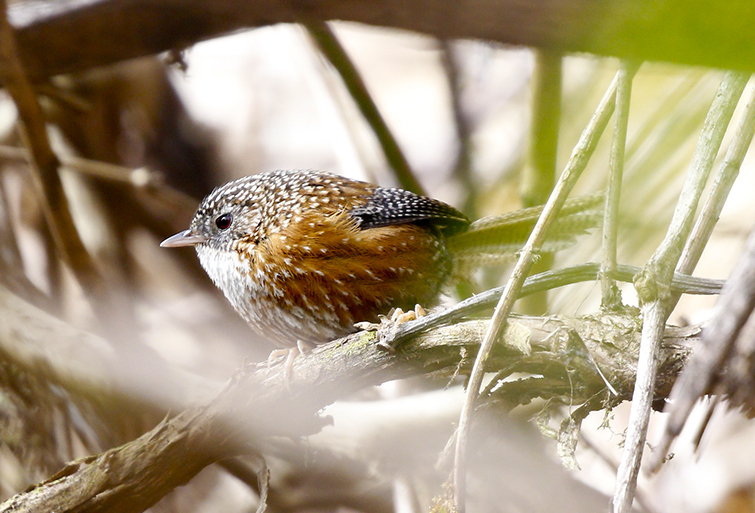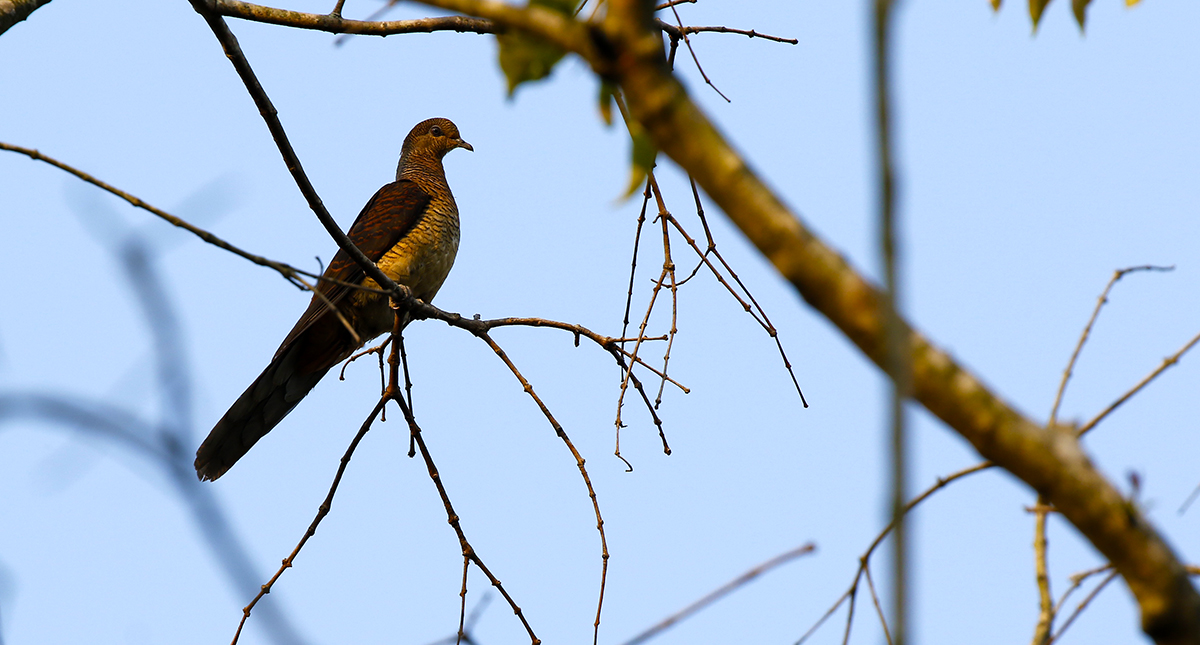A Birding Trip to Arunachal Pradesh and Assam April 2019
Birds & Mammals of North-east India
With Vana Safaris April 2019
The northeast of India is one of the most productive & sought after birding destinations in the world. The incredible combination of various habitats & elevations in the Kaziranga- Eaglenest circuit boasts of great number of species of mammals and birds. From floodplain grasslands to trans-himalayas, this is a unique tour that is a must do for every birder.
Day 1 - Sunday, 23 April 2019 Kolkata
Kolkata is situated on the banks of the River Hugli and is close to the Bay of Bengal. Kolkata is on the Indo-Gangetic plain and is at sea level throughout. Most of the city was originally marshy wetlands and remnants are still to be found where it has escaped urbanisation or has not been converted into commercial wetland fishery use. 300+ years of human habitation has led to the establishment of mature trees and shrubs and large groves and gardens are common today. Most large cities in India hold a surprisingly diverse population of birds despite the ever-increasing bustle of humanity, dwindling habitat and life-threatening pollution. Kolkata city is no exception. Both local residents and the traveler to the city can expect to see well over a hundred species, over a few pleasant winter mornings, in the immediate neighbourhood of the city. Good birds like Stork-billed Kingfisher, Lineated and Blue-throated Barbet, Fulvous-breasted Woodpecker, Black-hooded Oriole, Bronze-winged Jacana, Chestnut-tailed Starling, Richard’s Pipit, Bengal Bushlark, Brown Shrike and others are relatively widespread and often common in and around the city.
Birding started early and within a few minutes of leaving the hotel the group was at the Rajarhat Wetlands and the Bengal Bushlark was in the bag. Within a short while a good view of the Oriental Pratincole was obtained through the scope and after a bit more time good birds like the Yellow Bittern, Open-bill Stork, Striated Grassbird, Zitting Cisticola, Greater Painted Snipe was sighted well by every one. After the morning birding at Rajarhat wetlands - the group headed back to the comforts of the hotel. Phil and I went looking for the Indian Pitta and the Firethroat that had been sighted in the last couple of weeks in Kolkata outskirts. It was also important for Phil to see the locations and plan things for the next year. Well- being a Sunday the local birders and bird photographers were out in droves looking for the two species - which made our task impossible. However some other good birds like the Indian Blue Robin, Lineated Barbet, Rufous Woodpecker, Brown Fish Owl, Black Hooded Oriole and a few other species made up for the lack of the Pitta and the Firethroat. Back at the hotel in the afternoon - it was good to relax and get ready for the early flight next morning.
Day 2 - Monday, 22 April 2019 Guwahati to Kaziranga
We landed Guwahati airport around 8:30 in the morning and drove straight to Kaziranga infinity lodge for lunch, with a small tea and pakora break on the way. It’s a 4-5 hour drive that passes through the unique landscape of Assam with crowded streets of some small town and villages and vast stretches of paddy fields with occasional waterbodies that keep throwing interesting birds on your way once in a while. We saw the Black- billed Rollers, Lesser Adjutant Storks, Black Drongos and also a lone bull elephant near Deepor Bheel. There were also forest guards keeping an eye on him to avoid any conflict with traffic and people. We reached infinity and checked into our rooms and after a quick lunch that included variety of authentic Indian dishes. After lunch we went straight to the safari in the central zone, closest to the resort. We were greeted by a number of birds and of course the majestic Rhinos, Elephants & Water Buffalos right in the first safari. Some highlight birds were A Pallas’s Fish Eagle on the nest, Spot-billed Pelican & Striated Grassbird.
Day 3 - Tuesday, 23 April 2019 Kaziranga
We got up early morning at 5, to search for the elusive Blue-naped Pitta at a nearby location. After a few minutes of initial search we heard the Pitta a few times but it never showed up
and didn’t call for long. We ended the search quickly as we had to reach the eastern zone for safari. Woolly-necked Stork, Lesser Whistling-ducks, Red Junglefowl, Orange-breasted Pigeon, Blossom-headed Parakeets, Hair-crested Drongos & Pale-chinned Blue Flycatcher were some of the interesting sightings. During the evening safari at the central zone, we sighted a Kalij Pheasant in display, Grey-headed Fish Eagle, Chestnut-headed Bee-eater but the showstopper was a beautiful Tiger in the fading evening light on the riverbank. We returned with the surreal scene etched in our memories.
Day 3 - Wednesday, 24 April 2019 Kaziranga
This morning we went birding along the Panbari forest and got great views of several birds such as the Hill Myna, White-throated Bulbul & Green-billed Malkoha. Heard a Great Hornbill really close and also saw a Malayan Giant Squirrel. From there we headed straight to the eastern zone for the morning safari and saw the Greater Adjutant, Eurasian Wigeons, Spotted Redshanks in breeding, Glossy Ibis and Crested Serpent Eagle with other commoners. We had Swamp Francolins in the scope on the far bank today and also glimpses of the skulking Slender-billed Babblers which kept calling really close.
Day 5 - Thursday, 25 April 2019 Kaziranga & Nameri
Morning Elephant Ride was excellent with close encounters with lot of Swamp & Hog Deer, Rhinos & a family of Wild Boar. After the ride, we did quick birding session and tried for the Blue-naped Pitta and got lucky with several brief but in-the-open views of this elusive bird as it hopped across narrow trails in an adjoining forest patch. We headed straight to the safari in the central zone from there and managed to get the Slender-billed Vultures, Dusky Warbler, Great Myna & Square-Tailed Drongo Cuckoos. We packed after the safari and left for Nameri. After lunch we did a short walk from the campsite to the river, highlights were the beautiful River Hornbill that flew across the river. We returned early to rest as we had a long walk into the Nameri Tiger Reserve scheduled next morning.
Day 6 - Friday, 26 April 2019 Nameri
We had an early tea and picked up our packed breakfast, all set for the walk into the Nameri forest to get the rare White-winged Duck. On the way we got a lovely Ruddy Kingfisher, the Indian & Great Thick-knee, Dollarbird, Great Hornbill etc. After carefully checking every pond on the way we finally got the White-winged Duck, calmly swimming and feeding in the last pond. We observed it for some time in the scope and quietly turned around. We saw the Abbott’s Babbler, Common Kingfisher & a Sand Lark on the way back. In the evening we did a short walk around the campsite and enjoyed the antics of a Capped Langur troop, and also visited the Pygmy Hog Conservation centre.
Day 7-11 Saturday, 27 April 2019 - Wednesday, 1 May 2019 Nameri - Eaglenest WLS Camps
We started post-breakfast in hope to reach Eaglenest WLS.
Eaglenest (or Eagle’s Nest) Wildlife Sanctuary (27º02´–09´N 92º18´–35´E; 200–3,200 m) and Sessa Orchid Sanctuary (hereafter SOS; 27º06´–10´N 92º27´– 35´E; 250–3,000 m) are located in West Kameng district, Arunachal Pradesh, in north-east India. Both ENS (217 km²) and SOS (100 km²) were notified as protected areas in 1989. The Kameng river and its tributaries (Tipi and Sessa) drain the area. There are a number of small natural pools on the Piri-la ridge at 2,600–2,900 m, which range in size from tiny pools to 0.2 ha. Annual rainfall varies from <1,500 mm onorthern slopes to >3,000 mm on the southern slopes. Heavy snowfall is experienced in winter on Piri-la, while it is medium to low in other areas (especially above 2,000 m, occasionally down to 1,800 m). There are diverse habitat types because of the great altitudinal range. Tropical wet evergreen and semievergreen forest occurs in the southern parts of both the sanctuaries, especially in the river valleys and stream gorges, mainly below 900 m. ENS, SOS and adjacent areas are among the last large tracts of contiguous wilderness left in Arunachal Pradesh. This region is part of a global biodiversity hotspot (Myers 1988, 1991) and part of the Eastern Himalaya Endemic Bird Area (Stattersfield et al. 1998). It is nothing short of a birding pilgrimage for any birder to visit this area and get to see the Himalayan birds of this area. A high diversity of mammals. butterflies and moths along with a huge variety of flowering trees keeps the observer busy and occupied even when the birding is not so great.
However the rain-gods had other plans. But after entering Arunachal at the Bhalukpong entry gate and driving for another 15 km. We came to a halt due to 3 heavy landslides. We assessed the situation and thought it’d probably take more than one day to cleat the debris and open the road. So after some to and fro discussions with the back office and the driver we decided to take an alternate route from Orang and reach Lama Camp. We had lunch on the way, picked up some fruits and groceries and finally reached Lama camp around 6 pm. Due to the long drive we avoided having any extra stops for birding but we did manage a couple of species on the way. We stayed at Lama camp that night. Next 3 nights were spent at Bompu and again last night was spent at Lama camp. We mainly covered the areas between Lama Camp & Sessni (below Bompu). Target locations being Bompu, Sessni & below, Sunderview, Chaku, Eaglenest pass. Although we were hit mostly by pretty bad weather on every day and had really short birding windows between ‘foggy-very foggy- impossible to see’ weather pattern with some intermittent drizzle, we braved it everyday with multiple birding sessions and managed to get decent views many target species. Highlights were Green & Purple Cochoa, Hill Partridge, Kalij Brownish-flanked Bush Warbler Pheasants, Asian Emerald Cuckoo, Grey Nightjar, Golden-throated Barbet, Grey-chinned & Short-billed Minivets, Pygmy Cupwing, Grey-bellied Tesia, Chestnut-headed Tesia, Black-faced Warbler, Mountain Tailorbird, Broad-billed Warblers, a number of Leaf Warbler species, Golden-breasted, Rufous-winged & Yellow-throated Fulvettas, White- breasted & Black-throated Parrotbills, White-naped, Whiskered, Stripe-throated ,Black-chinned& Rufous-vented Yuhinas, Golden & Rufous-capped Babblers,Rufous-throated Wren Babbler, Slender-billed & Streak-breasted Scimitar Babbler, Grey-throated Babbler, Blackish-breasted Babbler (Sikkim Wedge-billed Babbler), Spot-throated Babbler, Himalayan Cutia, Striated, White-crested, Bhutan, Chestnut-crowned, Grey-sided & Blue-winged Laughingthrushes, Beautiful & Rufous-backed Sibia, Bugun Liocichla, all Minlas, Large & Small Niltavas, Lesser Shortwing, Spotted Elachura etc. We also incidentally spotted a few rare mammals such as the Himalayan Masked Civet & Leopard Cat.
Day 12 - Thursday, 2 May 2019 Lama & Sangti
We tried for the Bugun Liocichla in the morning around Lama camp, before breakfast and some of us managed to get brief but good views of the bird. Some of us made excellent recordings of the singing individual. On the same trail we had the Scarlet Finches & Gold-naped Finches. Later, we headed back to the campsite, had our breakfast, packed and started our journey to Dirang. On the way we got mixed flocks of Minivets, Sibias, Sunbirds, & Flycatchers. We got a few Blue- capped Rock-thrushes down on this road. Drive to Dirang was comfortable but we didn’t stop much due to traffic and nick of time as we had planned for an afternoon session at Sangti valley. We reached the hotel at Dirang, took our lunch and after quick rest started for Sangti Valley. Sangti valley is a picturesque village on the bank of Sangti river. Our main target here was the Long-billed Plover which we managed to find within first five minutes. Further in the riverbed we found some more Long-billed Plovers, Common Sandpipers, White Wagtails. Some of the important species we managed to see were Slender-billed Oriole & Yellow-breasted Greenfinch.
Day 13 - Friday, 3 May 2019 Sela & Dirang
To reach the magnificent Sela Pass (4200 masl) for pheasants, one needs to wake up at ungodly hours. we decided to start at 3:00am and drove much of the distance in the dark. Beyond Baisakhi we stopped at a couple of vantage points and good lookouts to look for Pheasants. I heard a Monal & some Snow Partridges. I scanned the valley and shouted, a Monal-Monal- Monal. I straight ran to the parked car to fetch the scope. Phil and I, got the Monal in the scope and we all were in sheer awe of the beauty of this magnificent species. Even Rinku, our driver enjoyed the view for some time and kept mentioning how beautiful this bird was. We also scoped out an Alpine Thrush, giving out its unmistakable scratchy song. Top of Sela was foggy & cold but we got some excellent views of at least 30 Grandalas around the lake. Some Rosy Pipits roamed by singing intermittently. We also got lucky with a few views of the Brandt’s Mountain Finches which are uncommonly seen around here. The weather like it rapidly changes in the hills, became windy & chilly, with plenty of fog coming in. We decided to take the much needed break and the hot tea and maggi noodles came to the rescue. We drove further ahead on the road with no luck with the weather and decided to head back. Made a quick stop at a local hotel for some lovely lunch and went straight back to the hotel to take the much necessary rest.
Day 14 - Saturday, 4 May 2019 Mandala & Dirang
We started around 5:30 am to Mandala and were soon greeted by a Plaintive Cuckoo & the Blue-throated Flycatcher nicely singing despite the constant drizzle. Close by a Chestnut-headed Tesia showed up itself pretty well. Up around the Mandala road we managed a brief view of a Thrush followed by excellent views of a Himalayan Buzzard. In the bushes a Brown Bush Warbler was singing its odd song, while a Brownish-flanked Bush Warbler added to it. The efforts to get any good views of the Spotted Laughingthrushes were futile due to bad fog and rain but we did manage a lovely view of the Crimson-browed Finches. There were also Russet Bush Warblers, 3 species of Yuhinas, Blackbirds, Sunbirds. Post-lunch session added a Rusty-flanked Treecreeper around beautiful Rhododendron forest to our list.
Day 15 - Sunday, 5 May 2019 Dirang & Tezpur
Due to the probability of road blocks on the regular Bhalukpong route (a result of the recent earthquake & the Phani cyclone on the east coast) we decided to take back the alternate Orang route which was excellent to drive on. It also gave us a few birding opportunities enroute that added a few birds to the final list such as the White-throated Needletails, Nepal House Martins, Black Eagle and the Siberian Stonechat.
Day 16 - Monday, 6 May 2019 Guwahati & outbound
Tezpur to Guwahati was a long but comfortable drive through the busy streets of several small Assamese towns and with the respite of a tea break. We were soon onboard our flights to Kolkata and eventually the journey back home with vivid memories and a list of over 300 species from the northeastern India.



























